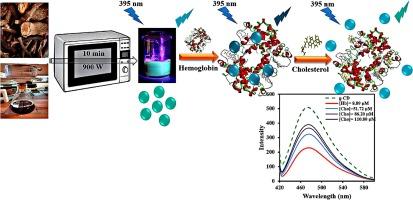Hemoglobin-Capped carbon dots synthesized via microwave green approach as a biosensor for specific cholesterol detection
IF 4.9
2区 化学
Q1 CHEMISTRY, ANALYTICAL
引用次数: 0
Abstract
This study explores the potential of hemoglobin-capped green-synthesized carbon dots (g-CD) as a biosensor for the specific detection of cholesterol. The CDs, synthesized using an environmentally friendly and convenient microwave green approach, derived from Wood Extract of Wild Cherry Shrub and utilizing hemoglobin as a capping agent, offer promising characteristics for cholesterol detection. This green synthesis method avoids the use of toxic precursors, making the process safer and more sustainable. Additionally, microwave (MW) heating, being volumetric in nature, reduces the synthesis time and energy consumption, resulting in a uniform and unique microstructure, offering a substantial advantage over traditional methods. Through fluorescence spectroscopy, the interaction between the g-CD/Hb complex and cholesterol was investigated. The results demonstrate that the fluorescence intensity of the g-CD/Hb complex increases with the concentration of cholesterol, suggesting a potential application for cholesterol detection. Notably, the calculated limit of detection (LOD) was found to be 9.22 μM, significantly lower than previously reported sensors, indicating higher sensitivity. Moreover, the biosensor exhibits high selectivity towards cholesterol over other biomolecules commonly found in human serum. Additionally, the biosensor shows excellent performance with real human blood samples, indicating its practical utility in clinical settings. Overall, the g-CD/Hb biosensor presents a promising approach for the specific detection of cholesterol, offering potential applications in biomedical research and clinical diagnostics. The key innovations include the use of a green and rapid synthesis method, improved detection limit, and validation of performance in real samples, distinguishing this sensor from previous research.

通过微波绿色方法合成的血红蛋白封接碳点作为特异性胆固醇检测生物传感器
本研究探讨了血红蛋白封端的绿色合成碳点(g-CD)作为生物传感器特异性检测胆固醇的潜力。这种碳点采用环保、便捷的微波绿色方法合成,提取自野生樱桃树的木质提取物,并利用血红蛋白作为封盖剂,具有检测胆固醇的良好特性。这种绿色合成方法避免了有毒前体的使用,使工艺更安全、更可持续。此外,微波(MW)加热具有容积性质,可减少合成时间和能耗,从而获得均匀独特的微观结构,与传统方法相比具有很大优势。通过荧光光谱,研究了 g-CD/Hb 复合物与胆固醇之间的相互作用。结果表明,g-CD/Hb 复合物的荧光强度随胆固醇浓度的增加而增加,这表明它有可能应用于胆固醇检测。值得注意的是,计算得出的检测限(LOD)为 9.22 μM,明显低于之前报道的传感器,这表明该传感器具有更高的灵敏度。此外,该生物传感器对胆固醇的选择性高于人血清中常见的其他生物大分子。此外,该生物传感器在真实人体血液样本中表现出卓越的性能,表明它在临床环境中具有实用性。总之,g-CD/Hb 生物传感器为胆固醇的特异性检测提供了一种前景广阔的方法,有望应用于生物医学研究和临床诊断。该传感器的主要创新点包括采用绿色快速合成方法、提高检测限以及在真实样本中进行性能验证,从而使其有别于以往的研究。
本文章由计算机程序翻译,如有差异,请以英文原文为准。
求助全文
约1分钟内获得全文
求助全文
来源期刊

Microchemical Journal
化学-分析化学
CiteScore
8.70
自引率
8.30%
发文量
1131
审稿时长
1.9 months
期刊介绍:
The Microchemical Journal is a peer reviewed journal devoted to all aspects and phases of analytical chemistry and chemical analysis. The Microchemical Journal publishes articles which are at the forefront of modern analytical chemistry and cover innovations in the techniques to the finest possible limits. This includes fundamental aspects, instrumentation, new developments, innovative and novel methods and applications including environmental and clinical field.
Traditional classical analytical methods such as spectrophotometry and titrimetry as well as established instrumentation methods such as flame and graphite furnace atomic absorption spectrometry, gas chromatography, and modified glassy or carbon electrode electrochemical methods will be considered, provided they show significant improvements and novelty compared to the established methods.
 求助内容:
求助内容: 应助结果提醒方式:
应助结果提醒方式:


